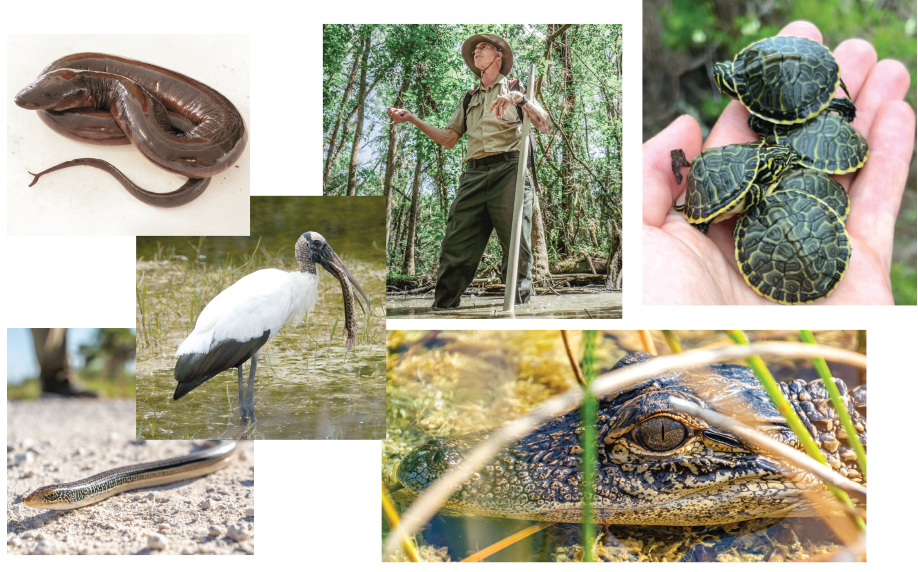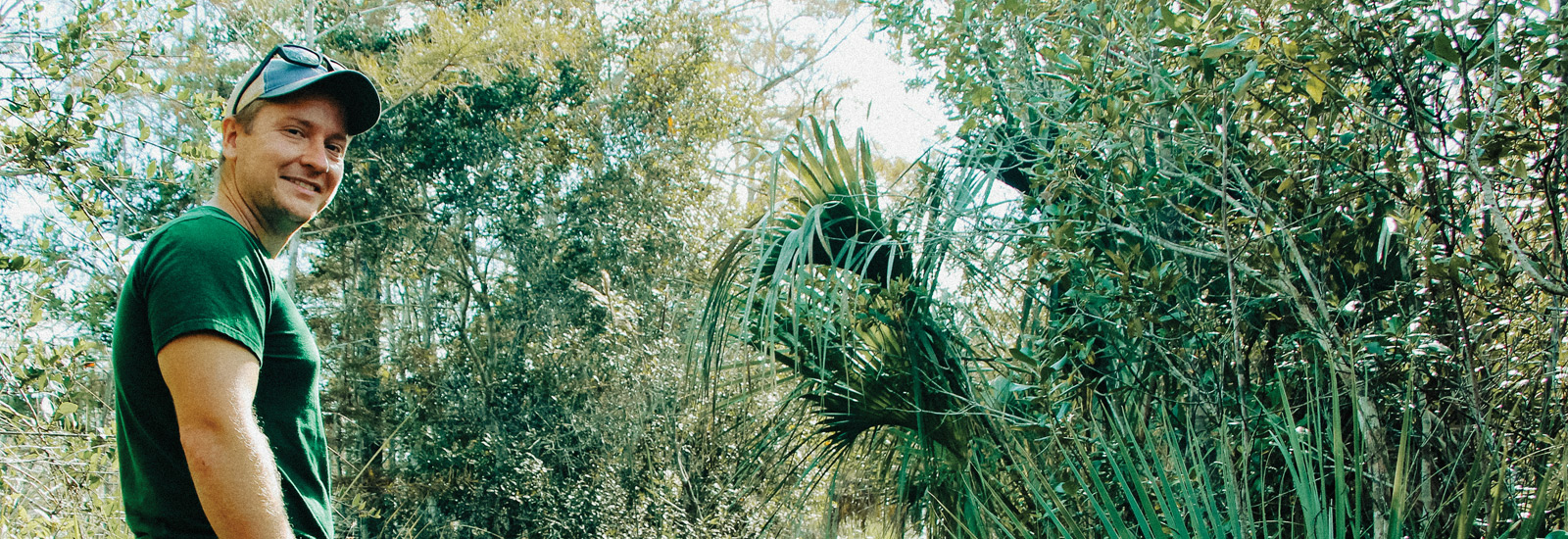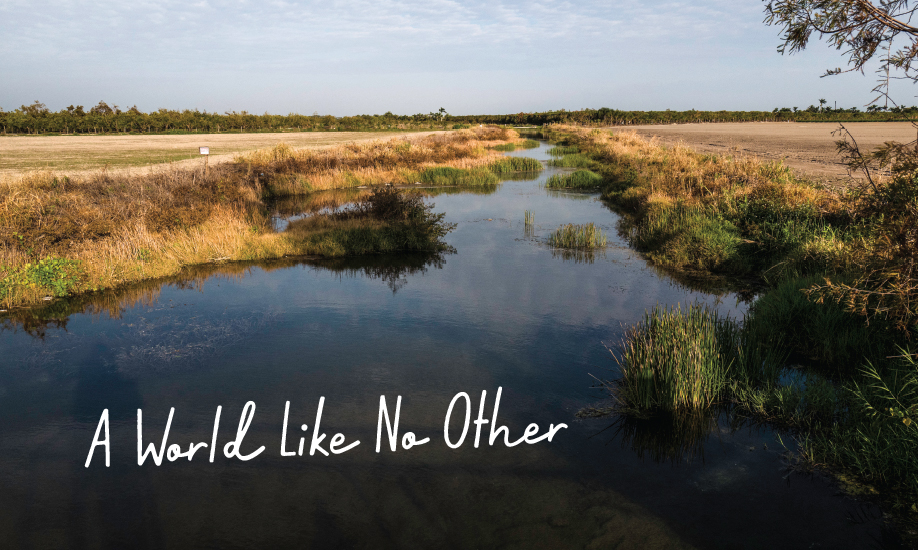by MICHAEL R. MALONE
PHOTOS BY HUNTER HOWELL AND KIM GRINFEDER
AS HE SQUELCHES THROUGH THE SWAMP, HUNTER HOWELL KEEPS HIS EYES PEELED AND SENSES KEENLY TUNED. HOWELL IS TRACKING SALAMANDERS—ESPECIALLY GREATER SIRENS AND TWO-TOED AMPHIUMAS—AND AS HE SLOGS THROUGH THE WATER HE’S SCANNING ITS DEPTH AND COLORATION FOR SIGNS THAT THESE SLINKY, SOMETIMES HUGE AQUATIC CREATURES ARE NEARBY.
From the visual variations in water and soil, Howell deciphers the type of vegetation and the thickness of the muck, all clues to knowing where to spot these particular salamanders, a main focus of his research in the Everglades—the vast, unique South Florida ecosystem that has been his classroom since he arrived at the University. “You just got to be out there practicing; it’s just like everything else,” says Howell. “You start to get a sense of where the salamanders like to be and where your traps can be the most effective. It’s all about being out there.”
And Howell has been “out there” a lot as part of his studies. He’s scheduled to receive his doctorate next spring, and that diploma will represent a unique and extraordinarily valuable skill set and knowledge base. Howell has spent 10 consecutive years in college, the past six at the University where, buoyed by the prestigious Dean’s Fellowship, National Science Foundation graduate research fellowship, and other grants, he has advanced his life’s calling as a conservation biologist.
On a recent Sunday morning this fall, Howell was in his habitat—the Big Cypress National Preserve. Birds arced and glided in the azure sky above, and alligators lounged close by in the fenced canal. He wore a green University “Grad Student” T-shirt, donned a Kings Canyon National Park 1940 cap, and shared his fascination with the Everglades.
“There’s no other place like this in the world,” he says. “I just really like getting out here. Even when I’m not working during the winter, I’m normally out camping, either at Flamingo or over on Bear Island and going for hikes, cruising at night trying to catch snakes, doing wildlife photography, invasive species removal— whatever,” he adds. “I’ve just fallen in love with the place and consider it a great honor, honestly, to be able to work on protecting it and to be a piece of the puzzle that works on understanding and protecting this place.”
Howell is a herpetologist, a person who studies reptiles and amphibians or, as he says, I study creepy, crawly things.
His inclination to protect and understand the natural world began early. He grew up near Baltimore, Maryland, and developed an early awe and affinity for the spotted turtle.
“It’s an amazing, completely armored animal unique in its defensive structure,” explains Howell. “As part of their evolutionary history, the shoulder girdle has shifted inside their rib cage skeletal structure, and their effective life history strategy has allowed them to outlive the dinosaur.”
By sixth grade he was excelling in life sciences and biology and closely tracking the exploits of Steve Irwin, the acclaimed Australian zookeeper, conservationist, and wildlife expert, on the television series, “The Crocodile Hunter.”
“I loved his ethos—he really just wanted to save the world—to make as much money as possible to buy land to conserve it to protect wildlife,” recalls Howell, admitting that he began to see himself as a wildlife “Hunter” as well. He found inspiration, too, when he read Aldo Leopold’s classic “A Sand County Almanac” in middle school.
Howell went on to attend Towson College, majored in biology with a focus on organismal ecology, and earned his B.A.—the first in his family to earn a college degree. The opportunity to continue his studies at the University of Miami offered thrilling possibilities.
He visited Miami and met with Chris Searcy, an associate biology professor in the College of Arts and Sciences. Searcy would become his advisor and mentor.
Howell has a vivid recollection of his first visit to the Everglades, Marjorie Stoneman Douglas’ celebrated “River of Grass,” an environmental wonder he had only imagined up to then.
“It was a crisp clear day in January, and we were on the Anhinga Trail. I had never seen a wood stork in the wild, and it had always been my dream to see one—and there it was. It was so cool, and then to see the softshell turtles swimming through the water and alligators basking everywhere. It was incredibly impressive in the middle of winter to see all that diversity,” Howell notes.
His research focuses broadly on understanding what’s happening with the reptiles and amphibians and how management practices are impacting them. Ultimately, together with Searcy and colleagues, the team will provide recommendations to the South Florida Water Management District (SFWMD) and Everglades National Park with the aim of conserving those species in the future.
The research has three major focus areas. First, Howell is analyzing long-term data sets to see what has changed and to assess the cause. He has compared data from two sets for the period 1996-2019 and determined there’s been roughly a 75 percent decline in the Everglades’ amphibian abundances.
Second, since 2018, he has been working on the grounds of the Arthur R. Marshall Loxahatchee National Wildlife Refuge, specifically at the Loxahatchee Impoundment Landscape Assessment (LILA), an 80-hectare landscape model and living laboratory for Everglades restoration near Boynton Beach, Florida. By implementing management strategies in a controlled area—such as changing the hydrological regime or the amount of water flow through the ecosystem—the team is trying to figure out how that’s impacting the community composition. Together with other scientists such as Eric Kline of SFWMD and Mark Cook, LILA’s scientific director, they’re conducting invasive species removal to assess whether the impact is positive and worthwhile.
The largest and most recent component has been the focus on understanding the natural history of the giant aquatic salamanders—their diet, population dynamics, and home ranges—and then updating the Everglades energy flow model with the new information about those species.
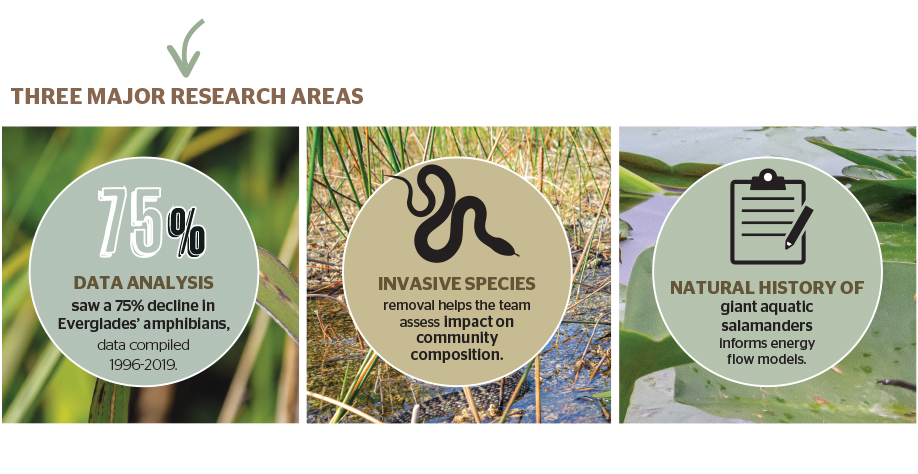
Sirens and the amphiumas are some of the largest extant amphibians in the world, yet Howell is aware of only one study on the latter and none on the sirens within the Everglades ecosystem.
“We’d been catching a lot of them at the study site, and knowing that they were understudied really inspired us to study them,” he points out. “Our estimates are that their densities are five to six times what we originally thought.”
That abundance may be critical. The sirens primarily eat apple snails, and the amphiumas primarily eat crayfish, which means they’re eating the same food sources as wading birds—a principle focus of Everglades conservation.
His team has yet to determine whether the competition for the food source is impacting the wading birds. Howell highlights the nuanced interdependences ever present in the ecosystem.
“There could be just so many snails, so many crayfish, that the limiting factor is not that the salamanders are eating too many crayfish, but instead it’s that the ibises just can’t find enough of them fast enough to keep eating them. We just don’t know yet,” the herpetologist explains.
Studies such as Howell’s require incredible diligence and no small degree of inconvenience.
One study spanned 10 weeks and required four weeks from mid-July to mid-August of consecutive workdays for field visits. Up at 5 a.m., to the lab by 5:30 a.m., then either a drive to the airport to catch a helicopter or travel by airboat or canoe to get to any one of 30 different research sites spread across the entirety of the 1.5 million acres of the slow-moving swamp—60 miles wide and 100 miles long— to check the traps and log the readings, then on to the next site until afternoon and then make the trip back home.
Despite delays with travel and getting funds administered, complicated logistics and transport, and hours on site in the sweltering summer heat, the experience was wondrous.
“I didn’t really think that I’d ever get to do that kind of work because it’s very logistically challenging,” says Howell, pointing out that because management of the Everglades is divided—SFWMD manages the water conservation areas, and the Department of Interior manages Everglades National Park—research is often siloed. Few biologists get the experience he did.
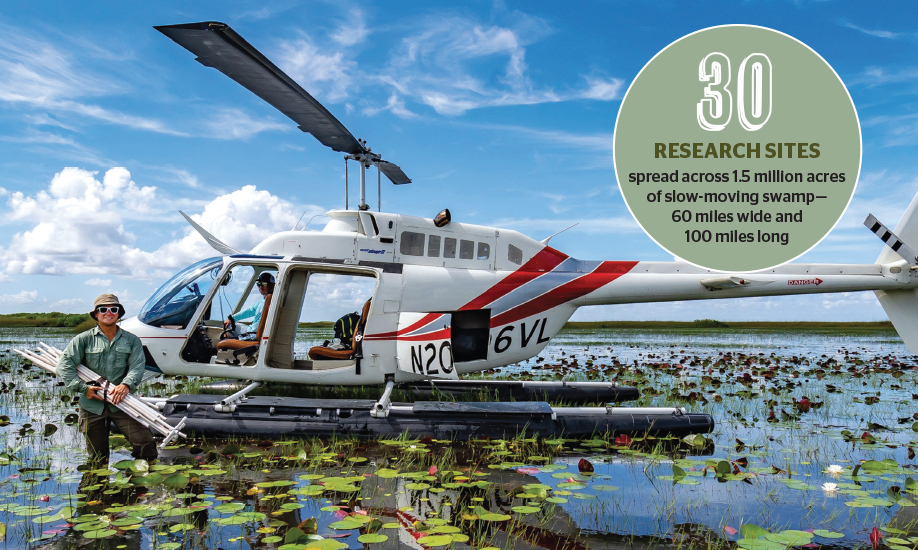
It was tons of work, but very, very cool getting to see the entire Everglades ecosystem from top to bottom.
“All the way south of Lake Okeechobee to the top of Loxahatchee National Wildlife Refuge, down to basically where the mangroves start. It was a huge area to cover,” Howell says.
Howell is excited to pass the research baton on to a protégé, a new Ph.D. student partner who has joined the research team.
“I wish I could just do a brain dump and transfer my brain files over to him instead of him having to go through it all,” says Howell, then runs through a long list of basic stuff—annual samplings that must be done the same way to keep the data consistent and comparable, skills on how to pick and tag, radio tracking, and implants with the polymers. “It’s complicated, but easy enough to teach.”
Howell is especially proud of the salamander research—the largest ever conducted—and hopes those studies will continue. He emphasizes the collaborative inroads made with SFWMD and LILA and says the decisions about what will be studied going forward and new planning goals will be decided at the upcoming stakeholder meeting that involves professors Searcy and Michelle Afkhami, who has been working with students in the Everglades since 2018, and other biologists.
After 10 straight years of college, Howell is “very, very ready” to graduate and move on in his career. He and his romantic partner, a specialist in emergency medicine—the two bonded over a discussion about venomous snakes—will soon learn the location of her medical residency, and the two will travel wherever she’s assigned. Howell will explore optimum opportunities for his ophiophilist instincts.
Given what he has learned, as he looks to the horizon, does he feel hopeful for the Everglades as an ecosystem?
“Being a conservation biologist is a very depressing field, especially right now,” Howell answers.
He references a restudy of his favorite spotted turtles that compared two periods 1986-1993 with 2014-2017. The results followed the same trend as that of the study on amphibians: a 50-percent decline in the abundances of the turtles. Howell points to increased development that brings road mortality and mesopredators—raccoons, skunks, feral cats, and all those things that predate nests and juvenile turtles—as the major culprit.
“Yet the work in the Everglades is definitely encouraging—it’s the largest and most expensive restoration project in the whole world ever initiated,” Howell says. “So, the fact that just enough people care enough and that Congress is spending money here is really good.”
He highlights the regrowth in bird populations, noting that the numbers of wading birds, waterfowl, ducks, and others are at historical values.
“There’s a huge amount of effort put into conserving those populations, so that they can exist in the future,” he says. “Yet that shows you that when you have targeted management actions, it works, and we can restore these populations. We have evidence that that’s the case.”
Howell highlights the juxtaposition that some species are rebounding while overall the scenario remains bleak.
“There’s a lot of Everglades restoration work I’m involved in that shows reason to be optimistic about certain populations, but in general a lot of things are declining quite rapidly in front of our eyes. We don’t seem to be doing as much as we need to, to prevent that from happening,” he notes.”
